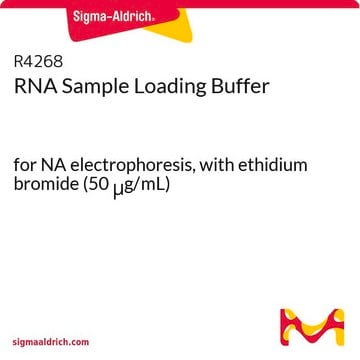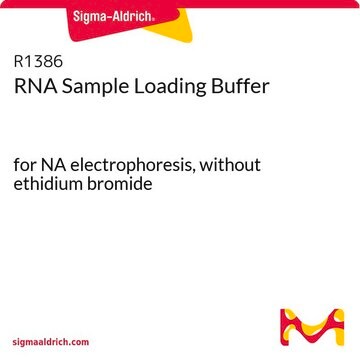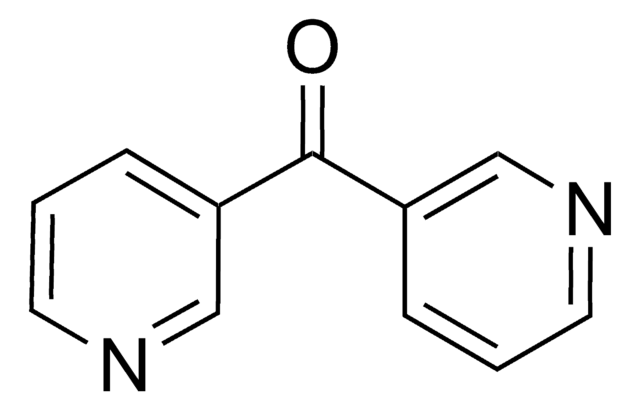G7654
Gel Loading Solution
for NA electrophoresis, solution
Synonym(s):
DNA Gel Loading Solution, Gel Loading Buffer
Sign Into View Organizational & Contract Pricing
All Photos(1)
About This Item
UNSPSC Code:
12161703
NACRES:
NA.25
Recommended Products
Related Categories
General description
Gel loading solution is used as a tracking dye during electrophoresis. The dyes have a slight negative charge and will migrate the same direction as DNA, allowing the user to monitor the progress of molecules moving through the gel. The rate of migration varies with gel composition. Dilute 1:6 with sample before loading.
Application
Suitable for use with agarose or non-denaturing polyacrylamide gel electrophoresis (PAGE), which may be part of Northern and Southern blot hybridization procedures.
Components
Gel loading buffer contains 0.25% bromophenol blue, 0.25% xylene cyanol, and 40% sucrose.
Other Notes
Band migration can be expected as follows:
On polyacrylamide gels, xylene cyanole comigrates with approximately 450-460 bp DNA, while bromophenol blue comigrates with 15-100 bp DNA. On 0.5 – 1.4% agarose gels, xylene cyanole comigrates with 4 kb dsDNA, while bromophenol blue comigrates with 300 bp dsDNA.
On polyacrylamide gels, xylene cyanole comigrates with approximately 450-460 bp DNA, while bromophenol blue comigrates with 15-100 bp DNA. On 0.5 – 1.4% agarose gels, xylene cyanole comigrates with 4 kb dsDNA, while bromophenol blue comigrates with 300 bp dsDNA.
related product
Product No.
Description
Pricing
Storage Class
12 - Non Combustible Liquids
wgk_germany
WGK 2
flash_point_f
Not applicable
flash_point_c
Not applicable
Certificates of Analysis (COA)
Search for Certificates of Analysis (COA) by entering the products Lot/Batch Number. Lot and Batch Numbers can be found on a product’s label following the words ‘Lot’ or ‘Batch’.
Already Own This Product?
Find documentation for the products that you have recently purchased in the Document Library.
Customers Also Viewed
S Henry et al.
Vox sanguinis, 70(1), 21-25 (1996-01-01)
While screening Le(a+b+)Polynesian DNA samples for a candidate Se(w) allele, a point mutation (C571-->T) resulting in a new stop codon (Arg191-->stop) in the alpha(1,2)fucosyltransferase gene (FUT2) was identified. This point mutation resulted in the gaining of a new restriction enzyme
Sambrook, J., et al.
Molecular Cloning: A Laboratory Manual, 6-6 (1989)
David R Macinga et al.
Antimicrobial agents and chemotherapy, 47(8), 2526-2537 (2003-07-25)
We have characterized an early series of 5,6-bridged dioxinoquinolones which behaved strikingly different from typical quinolones. The 5,6-bridged dioxinoquinolones inhibited Escherichia coli DNA gyrase supercoiling activity but, unlike typical quinolones, failed to stimulate gyrase-dependent cleavable complex formation. Analogous unsubstituted compounds
M K Bolla et al.
Journal of lipid research, 40(12), 2340-2345 (1999-12-10)
The apoE gene exhibits two common polymorphisms that have been associated with both coronary artery disease and Alzheimer's disease. The polymorphisms create the three allelic isoforms E2, E3, and E4 which are encoded by Cys;-Cys, Cys;-Arg, and Arg;-Arg at amino
Jung-Lim Lee et al.
Journal of microbiological methods, 67(3), 456-462 (2006-12-22)
Ethidium bromide monoazide (EMA) was utilized to selectively allow conventional PCR amplification of target DNA from viable but not dead cells from a broth culture of bacterial mixed flora derived from cod fillets. The universal primers designated DG74 and RW01
Our team of scientists has experience in all areas of research including Life Science, Material Science, Chemical Synthesis, Chromatography, Analytical and many others.
Contact Technical Service












